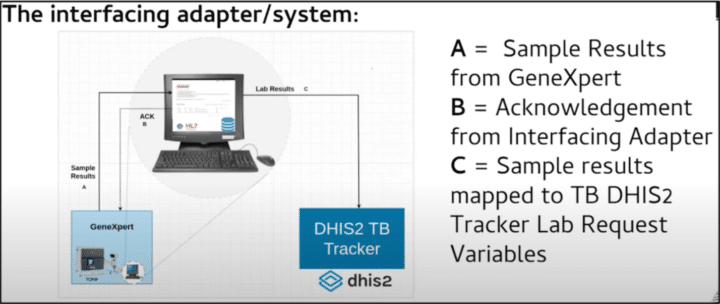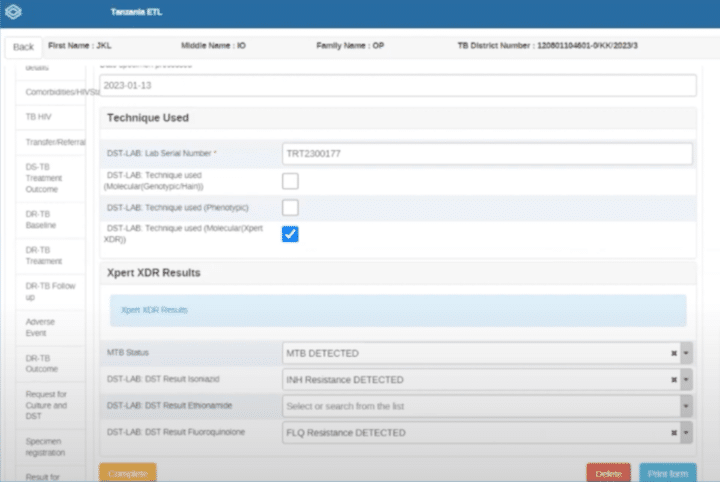Connecting laboratory test results with patient records in Tanzania and Ethiopia
The Ministries of Health of Tanzania and Ethiopia have integrated laboratory data from GeneXpert machines with DHIS2 to achieve seamless transfer of TB and COVID-19 test results, improving program management and patient follow-up
The availability of laboratory results is critical for the success of effective health programs, especially those targeted at highly transmissible diseases of public health significance such as Tuberculosis (TB) and Leprosy. Timely test data plays a pivotal role in diagnosing and treating diseases, monitoring the progress of health interventions, and making informed clinical decisions, which can greatly improve patient care by enabling swift initiation of appropriate treatment. Widespread and accessible COVID-19 testing, with rapid reporting of results, has also been instrumental in tracking and containing that virus’s spread, thus helping to mitigate the pandemic’s impact.
Thanks to support from the Global Fund, reliable and low-cost lab testing machines – such as GeneXpert – are now in use in many low- and middle-income countries (LMICs) to improve testing for TB and other diseases. However, inefficient manual processes for data transfer from lab systems to health information systems (HIS) limit how quickly these data can be used to inform decision making. Meanwhile, manual methods of reporting also result in data quality issues, with about 4% of errors in point-of-care laboratory services occurring due to transcription errors. Automating the transfer of lab data from testing machines to HIS can help minimize these errors and make test results available more quickly.
Recently, two countries have achieved this by successfully integrating GeneXpert with DHIS2. In Tanzania, the National TB/Leprosy Program partnered with the NIMR-Mbeya Medical Research Center through the Tuberculosis Implementation Framework Agreement (TIFA Project) – with funding from USAID and technical support from the University of Dar es Salaam (UDSM) DHIS2 Lab – to integrate GeneXpert machines with the DHIS2 Tracker-based national TB and Leprosy case-based system. This allows for direct transfer of TB laboratory results, eliminating manual data transfer and its associated errors. Meanwhile, in Ethiopia, HISP Ethiopia supported the national COVID-19 response by implementing DHIS2 Tracker for case-based COVID-19 surveillance and integrating it with test results from GeneXpert to facilitate rapid notification and follow up. The National TB Program plans to build on this innovation for improved TB program management.
Achieving greater efficiency in TB/Leprosy program management in Tanzania through DHIS2-GeneXpert integration
While TB prevalence in Tanzania has fallen by 32% from 2015 to 2021, Tanzania remains one of 30 high-burden TB countries. For TB/Leprosy control programs to succeed, precision diagnostics services need to be matched by accurate data reporting mechanisms. This often creates the need for expensive equipment and solutions. The GeneXpert machine is a low-cost, fast and reliable alternative for TB diagnosis, providing results in a matter of hours instead of days compared to traditional diagnostic methods. These features have made the machine quite popular in low-resource settings, and their rollout in many LMICs has been supported by grants from the Global Fund. However, test results from GeneXpert machines are not electronically shared with other systems, leading to a need to copy them manually, either by writing them by hand into paper registers or typing them into other digital systems. Both of these options are slow, and can result in transcription errors.
To ensure accurate transmission of results from GeneXpert machines to digital health platforms, several proprietary interconnection solutions currently exist. These solutions are generally expensive, require extensive support and have the potential for prolonged dependency on the developers for maintenance and modifications due to their proprietary nature. To achieve electronic linkage between GeneXpert test results and patient records without the need for a proprietary system, the MoH in Tanzania opted for a locally designed solution that leverages the DHIS2 platform, which has already been in use in-country for more than a decade. Consequently, the UDSM DHIS2 Lab developed an interoperability platform to transfer data between the GeneXpert machines and Tanzania’s existing DHIS2 Tracker system for case-based reporting of TB/Leprosy data (DHIS2-ETL), facilitating accurate and prompt capture of diagnostic results.
To do this, the team from UDSM developed an intermediary platform to collect laboratory results from the GeneXpert machine and translate them into a suitable format for onward upload into Tracker for case-based TB/Leprosy reporting.

The project started with four units of the 10-color GeneXpert machine installed at four different sites (all Zonal Labs in mainland Tanzania). The UDSM team developed an interface adapter as a go-between software layer, which transcribes laboratory results from the machine into the case-based DHIS2 platform. The interface adapter can be hosted on the computer attached to the GeneXpert machine, the server running DHIS2 or on a separate computer dedicated to running the adapter. This deployment versatility further enhances the adapters’ utility for different scenarios across all the laboratories.
The interface adapter was developed to simplify data transfer and as such, it was made with a simple, easy-to-use user interface to facilitate both ease of configuration, GeneXpert machine linkage and subsequent use. Once configured, the adapter can start transferring approved results either in automated mode whereby results are automatically transferred as they are generated by the machine without a user input, or in on-demand mode for user-directed transfer of individual approved tests.
To further simplify the system’s use, the team enabled a single-sign-on feature, allowing users to login using existing credentials on the DHIS2 case-based TB/Leprosy reporting system. This improves the user experience by eliminating the need to create and remember multiple accounts for each user.

The system can also serve as a mediator platform for transferring diagnostic and logistics data from GeneXpert to DHIS2. This helps program managers, not only to keep accurate track of laboratory diagnostics data but also to project future demands for associated supplies and consumables using more accurate logistics data. The system also facilitates the seamless transfer of data required to schedule and conduct maintenance activities on the GeneXpert machines, ensuring their optimum function for longer periods.
Following a successful pilot in 2023, this interoperability solution has the potential to be scaled to the remaining 342 GeneXpert machines located at 306 testing sites around Tanzania. As the DHIS2-based solution is not proprietary, it can also be expanded to connect other TB-testing machines such as Truenat.
Repurposing and integrating GeneXpert machines in Ethiopia for rapid COVID-19 testing
The COVID-19 pandemic that swept around the world in 2020 created an urgent need for countries to refocus their public health efforts and find innovative solutions to respond to this new health crisis. During the pandemic, HISP Ethiopia supported the Ethiopian Institute of Public Health in implementing DHIS2 Tracker for case-based surveillance of COVID-19 cases. In Ethiopia, as in many other LMICs, existing GeneXpert machines were repurposed from TB testing to COVID-19. Linking data in DHIS2 on suspected cases with laboratory test results from GeneXpert machines facilitated pandemic surveillance and response. However, one of the major challenges Ethiopia’s Emergency Operations Center taskforce faced was manually entering the large amounts of COVID-19 test data generated at the laboratory level from community-based outreach and mass testing campaigns into DHIS2. Without any integration between GeneXpert and DHIS2, this process was slow and prone to data entry errors.
To alleviate this challenge, HISP Ethiopia developed a custom laboratory reception app to link lab results with DHIS2 via GeneXpert/CEPHEID lab software. The app allows lab receptionists to accept batch tests from sample collection teams and link each test with a unique ID for each test/patient, the health facility where the test sample was collected, and a unique barcode. When the test result is ready, users simply scan the barcode and the system automatically updates the corresponding record in DHIS2. This substantially reduced workload and improved data quality. It made test results data available in DHIS2 much more quickly, facilitating rapid notification to patients, health workers, and the taskforce of positive COVID-19 test results.
As it did in many countries, the COVID-19 pandemic had a negative impact on Ethiopia’s TB surveillance in 2020, causing a drop in reported cases during the second quarter of the year due to disruption in routine health services and reallocation of limited testing resources. However, the pandemic has also produced some potentially positive outcomes for the National TB Program (NTP), as the DHIS2 innovations deployed during the pandemic are being incorporated into national TB management efforts. This includes the NTP’s adoption of DHIS2 Tracker for case-based TB surveillance and case notification, starting with a pilot for Multidrug-resistant TB (MDR-TB) that was successfully launched in September 2021 across 67 facilities, with funding from USAID and the Global Fund and technical assistance from JSI. The NTP plans to continue scaling up this case-based system to cover the entire cascade of care across all of Ethiopia’s approximately 6,000 health facilities. As part of this plan, the NTP has identified the integration of GeneXpert with DHIS2 as a key need to support effective data use and client follow up for TB.

Challenges and opportunities: How DHIS2/GeneXpert Integration can drive healthcare program success through timely access to quality data
In both of these cases in Tanzania and Ethiopia, integrating DHIS2 with laboratory testing machines has presented several challenges. One major hurdle is the shortage of trained personnel and a high turnover rate at data entry points. Furthermore, limited and unreliable internet connectivity poses a significant bottleneck, hindering automatic test data upload and real-time case-based data entry at the facility level. When data is instead captured on paper and entered into DHIS2 at the district level, this results in issues with timeliness and data quality, which can compromise the suitability of the data for informed decision-making. The inadequate availability of hardware and devices for data entry further contributes to delays and data quality concerns.
Despite these challenges, the integration of HIS with laboratory data offers a range of benefits, particularly in strengthening TB program monitoring and evaluation through accurate, timely, and complete diagnostic and logistics data. Using open-source, integration-ready tools like DHIS2 can help countries to achieve these benefits at a lower cost than with proprietary solutions. Looking forward, both Tanzania and Ethiopia plan to find ways to continue scaling up their case-based TB surveillance systems with DHIS2. This allows them to leverage existing systems, capacity, and innovative solutions developed during the COVID-19 pandemic to improve the effectiveness of their TB programs.
The section of this article on Tanzania is based on a presentation by Henry Kalisti of UDSM DHIS2 Lab at the 2023 DHS2 Annual Conference.


